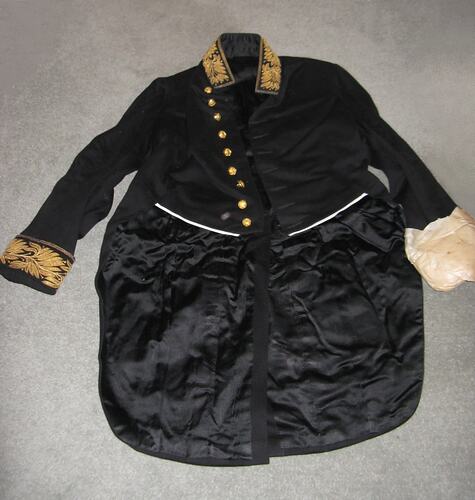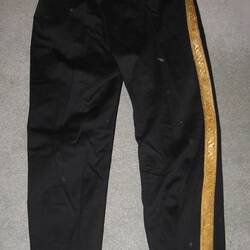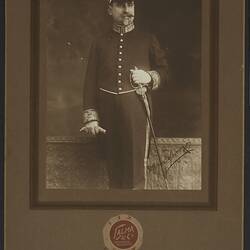Summary
Three piece uniform (tailcoat, trousers and hat) worn by Dr Constantine Kyriazopoulos when he was appointed as Honorary Consul for Greece for Melbourne from 1921 to 1923. Also surviving the original lid from the box in which the uniform was shipped to Melbourne from Greece. This box has two labels, including one for Ince Brothers, Tailors and Outfitters in Swanston Street Melbourne suggesting the uniform was perhaps adjusted. The collection also holds a photograph of Constantine wearing the uniform (MM 127456).
Constantine migrated to Australia from Greece in 1902, settled in Melbourne and returned to Greece in 1909 to arrange his marriage to Antigoni Dimissa whom he married in Melbourne that same year. A qualified doctor, his early years were difficult due to the non-recognition of his qualifications as well as his limited English language skills, both of which he overcame. He became a highly respected and active member of the local community and was appointed Consul for Greece for Melbourne from 1921 to 1923. Constantine had two children and he died in 1939.
Physical Description
Black brushed cotton uniform consisting of a tailcoat, trousers and bicorne hat. The coat has gold thread decorative leaf pattern around the upright collar, the sleeve cuffs and at the back of the coat, above the tails. It has a short front and long tails at the back and a strip of white lining is just visible along the bottom of the jacket front. There are nine gold buttons down the front with matching button holes, each button has embossed a coat of arms motif. There are also four buttons at the back at the top and bottom of the tails. The coat has a black satin lining which is stitched in quilting lines around the top and white lining inside the sleeves. There is no maker's label.
Significance
This collection holds enormous social and cultural significance for the state collection. Its value lies in its breadth of material (textiles, documents, tools and equipment, and photographs) and strength of its provenance. The story and the objects which belonged to Dr Constantine and Antigoni Kyriazopoulos enable the museum to both represent and explore key themes, including early 20th century, non-British migration; professional rather than the more common labour and trades category of male migration; early 20th century social and cultural life in Melbourne; female agency is creating migrant support networks; examples of individual discrimination in early 20th century Australia; and the maintenance and adaptation of a cultural identity through the process of migration and settlement.
The documents relate to the doctor's working life (business cards, letterhead and invoice, medical congress identity tag, professional qualifications certificate and diploma), his ongoing connections to Greek cultural life (Greek play booklets and periodicals), his position as Greek Consul (Victorian Government gazette announcement and Consul letterhead) and his decision to change his surname (deed poll), a common migrant experience. There is also a rare passport belonging to Antigoni demonstrating her return passage to Melbourne.
The clothing items, particularly the Greek consul uniform is an excellent example of active and visible cultural maintenance, as well as official recognition. The women's clothes and accessories (dresses, jackets, gloves, bags, belts) are significant as strong examples of their period, and as examples of clothing (procured both in Melbourne and in Greece) worn by affluent women of non-Anglo background in Melbourne in the 1910s and 20s. The collection of underclothes augment the museum growing collection of women's trousseaux which ranges across time and culture.
The medical case, brass plaque and medical tools offer tangible evidence of the doctor's professional tools of trade from this early period while the uniform and flags enable the representation of Consul activity in early 20th century Melbourne,
More Information
-
Collecting Areas
Migration & Cultural Diversity, Medicine & Health, Working Life & Trades, Public Life & Institutions, Clothing & Textiles
-
Acquisition Information
Cultural Gifts Donation from Mrs Fife Denovan, 14 Mar 2012
-
Issued To
Dr Constantine Kyriazopoulos, Melbourne, Victoria, Australia
-
Format
Photograph, Black & White
-
Classification
Governance, Victorian state government, Consulates & embassies
-
Category
-
Discipline
-
Type of item
-
Keywords
Greek Immigration, Greek Communities, Medical Workers, Uniforms, Men's Clothing, Governments




